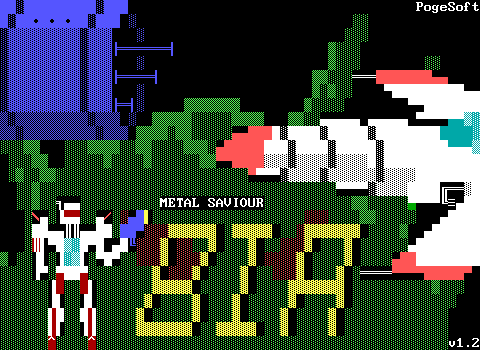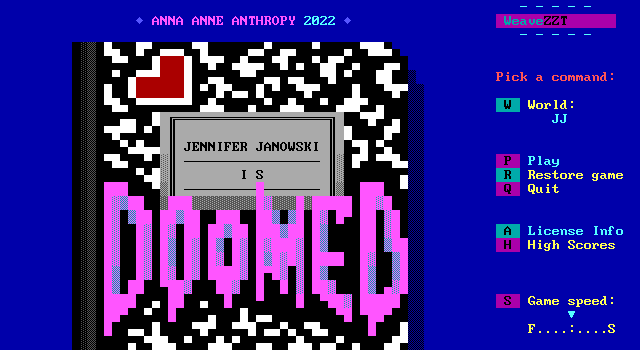
Jennifer Janowski is Doomed, Anna Anthropy's newest ZZT game from February 2022 stands out from other story-focused worlds by being designed for Weave ZZT. By embracing this new piece of tech to enhance ZZT games while easing the work put on those creating them, Anna shows off the Weave philosophy and creates a memorable story driven adventure and tale of undeclared teenage romance. It adds up to a game with some great atmosphere, a protagonist you'll be rooting for, and a great example of what Weave ZZT is and what it isn't.
The quality of your average ZZT world I would argue has increased significantly in recent years as the era of ZZT games made by high schoolers gives way to ZZT games made by adults whose schooling is frequently many years behind them. It's always tough to decide to make these newer releases featured worlds as so many of them really do go well beyond the standards of great ZZT games from the turn of the century. Grand ambitions give way to tighter games with deliberate designs rather than the old ways of making it up as you go along and hoping you know when to call it quits.
But even though this game is less than six months old, I feel like its connection to Weave gives it a leg up over other modern success like Phoebus Project, Cyber Purge, or Tales of Dragons. All of these games would be great fits for the featured status when I (or a guest volunteer) tries to give them their fair due, but it's the embracing of Weave's philosophy to remove the gotcha moments that create hurdles for new ZZTers and slow the pace of those who know how to deal with them that make Jennifer Janowski is Doomed a possibility for what ZZT games of the future might hold.
It's easy to forget when looking at a released game that it wasn't always that way. Whether it's Weave, classic ZZT, an alternative game making tool, or coding from scratch, everything starts with a blank canvas, and the hardest thing to do is actually paint it. From the overambitious announcements for projects that will surpass Code Red, the endless demos that go nowhere, to the high school notebook doodles planning lord knows what, it turns out that actually finishing something is worth celebration alone.
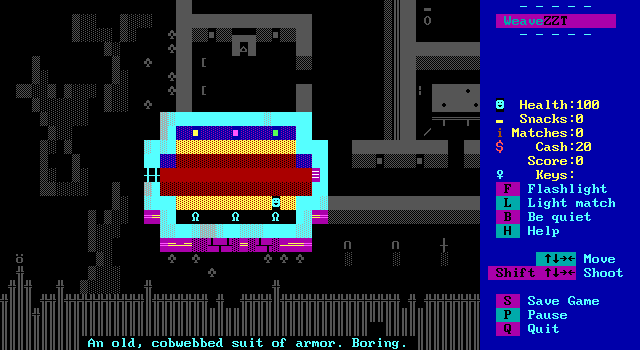
Jennifer Janowski is Doomed embraces Weave's ability to raise the ceiling of what ZZT can do without raising the floor of what is asked of the author in order to do anything. ZZT clones, whether we're talking the actually successful MegaZeux or the numerous failed offshoots like ZIG, deliberately try to distance themselves from ZZT and become something new entirely. Weave instead acknowledges that if ZZT has been working out for more than thirty years, that it's probably doing something right. The resulting Weave program instead encourages you to keep on creating ZZT games, but without the headaches and roadblocks that lead to projects being shoehorned to fit into what ZZT v3.2 permits if not scrapped entirely. Weave intends to be ZZT without compromise, and Anna here shows us exactly what that means.
Of course, Jennifer Janowski gives plenty more reasons to cheer than mere existence. The game has a foundation built on modern story based ZZT games like Atop the Witch's Tower and Ana, telling its story while the protagonist solves puzzles to continue forward on their journey. Yet Anna is also able to evoke feelings of dungeon crawls from ZZT's heyday with its winding caverns filled with weird mushrooms and dangerous underground rivers that will make fans of Testa, coolzx, and Hercules/Hydra's joint efforts feel right at home. Like the cited story worlds, Jennifer Janowski is a breezy feeling game, where the stakes may be high for Jennifer, but for the player at the keyboard they are safe from instant game overs, overwhelming combat, or constantly needing to load after making any mistakes in a puzzle.
Like a lot of modern ZZT design-ethos, Jennifer Janowski is a game that can be enjoyed by pretty much anyone. Easily beatable in a single sitting, and helpful towards those who have never played a ZZT game before, Jennifer Janowski shows us that games don't have to be the equivalent of a novel, a short story will do just fine.
Jennifer Janowski is Breaking and Entering
Jennifer Janowski starts just outside of the home that holds her doom. Set in 1993, high school student Jennifer Janowski has to pass initiation with the Fairhaven High Paranormal Society. The easiest way to do that would be to venture into the long abandoned Sallow house find some occult artifact, and make it out alive.
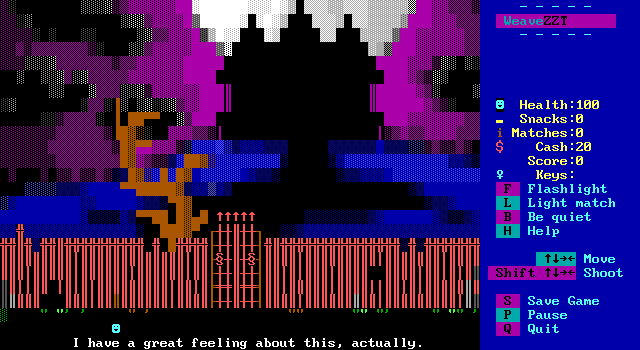
The characters work in the game's favor, helping to keep whether or not the house is actually haunted ambiguous. At the start of the game, the player won't have any real grounding for just how paranormal things might be. It's unclear if this is just kids telling each other ghost stories. At any minute it's just as likely that the other members of the paranormal society will jump out in a sheet and yell "Boo!" as it is that old lady Sallow will show up to drink your blood as part of an arcane ritual. It takes some time to figure out if Jennifer's biggest fear should be of being dismembered or just needing a tetanus shot.
Jennifer, like all teens, wants two things: to gain the acceptance of her peers (and perhaps a confidence boost to go along with it), and to win favor with her crush and paranormal society president, Dinah. High school crushes are a big source of motivation for crimes after all, and after crawling in through a broken part of the fence Jennifer soon finds herself exploring a house that has been ransacked by countless students on dares before.
Luckily for her, after investigating a portrait of a woman whose eyes definitely seem to be watching her every move, she stumbles across a secret passage where a rope leads down to the pitch black catacombs below...
Jennifer Janowski is Weaving Around Obstacles
Anna's decision to create the game for WiL's new Weave ZZT engine is the lynch-pin of the game's design. At the time of release, Janowski was the second Weave game to be completed excluding WiL's own creations with experimental and not yet general audience ready versions of the program, beaten only by asie's conversion of Wordle, Laworde. While not the first Weave game, I feel that Jennifer Janowski is Doomed exemplifies the Weave philosophy, and it wasn't until my most recent playthrough of the game that I realized this.
Throughout ZZT's life, several attempts have been made to clone or patch ZZT to address its shortcomings. These shortcomings have typically been addressed by adding support for things like custom graphics, better audio sources, increased limits, strings, prompts, arithmetic, sprites, and palettes. Most didn't last very far, and after more than thirty years the only program looking to be the "next generation" of ZZT that found any success has been MegaZeux. Others like Super ZZT traded away what weren't yet realized to be essential components of ZZT (though the source code now shows that Super ZZT's cuts were more to get it to cooperate with Turbo Pascal's own size limitations). In the early 2000s, ZIG had a bit of promise, but like most clones fizzled out before really catching on, and with a lack of critical features like save support, meant that while competent, it was never going to be worth creating giant ambitious projects in.
WiL even took a crack at it himself with a few variations on Plastic in the mid 2000s, but without a strong ZZT community to pull interest from, the experiment didn't spread particularly far. With lessons learned from the clones of the past, Weave takes an unusual approach to the ZZT clone.

Instead of aiming to be all about power, the program aims to take ZZT, and streamline it for ease of use both for players and creators. Laworde shows that power is certainly packed inside the program regardless, but its creation involved writing scripts to write code to text files and then linking it all together. The philosophy behind Weave is instead on making the programmer's life easier. It tries to keep itself faithful to ZZT by only performing manipulations ZZT already performs. Weave's goal is to strip ZZT of the headaches, especially for those looking at making ZZT without prior experience. It's easy to forget after years of creating ZZT games how unnatural its rules can be. Newcomers are given editors with full support for any colors ZZT can produce, and then told that they can't place green ammo with an object. They can't have an object change itself from red to blue. They can't just check if the player has a purple key.
With Janowski, Anna shows us what this streamlined process can result in. No more relying on player clones to change boards, or being stuck with torches that last a fixed amount of time. Janowski has the soul of a classic ZZT game, with none of the physical blemishes ZZTers have had to politely ignore for so long. Like a Super Nintendo game being ported to the Sega Genesis, (or vice versa,) shifting Janowski from Weave to ZZT v3.2 would be doable, but compromised. You'd be lighting torches endlessly, or having one permanently lit with its cycles remaining cranked up. Mushrooms that spring to life when exposed to torchlight would be forced to rely on clunky systems with stars to detect if a nearby tile was lit. Animated sequences would stuff the player in the corner and tell them to watch a smiley face perform actions like an out of body experience.
Would it still be fun to play? Oh, without a doubt. The real question is, would it be fun to create?

Weave presents the opportunity for ZZTers to make a ZZT game without having to stop and compromise with its unbreakable rules. The trick is to realize that while other clones want you to make <clone> games, Weave is a tool to make ZZT games. The enhancements exist not to push the limits of ASCII computer games, but to let you make that ZZT game you always wanted to without having to juggle zaps and restores, compress multiple flags into one, and write :shot nine times in a row because you want this enemy to take plenty of hits. Anna has clearly figured this out, and I hope that other who play this will understand the difference between what Weave is, and what it doesn't want to be: a worse version of MegaZeux. ("Shitty MegaZeux" as the community loves to dub this fear of what unrefined ZZT source code enhancements may result in.)
Jennifer Janowski is Operating Levers
Once beneath the house, Jennifer's search is hindered by numerous obstacles. This is no dungeon crawler, nor is it a retro romp of shooting spooky ghosts (lions) and creepy ghouls (tigers). The game is focused on telling a story above keeping the player shooting. In fact, thanks to Weave's ability to to change messages, so much as attempting to fire a bullet results in Jennifer calling out the player's unfounded assumption with: "Do I look like someone who carries a gun?". The gameplay here is instead relegated mostly to typical light ZZT puzzle mechanics that make use of ZZT-OOP. Navigation of the caverns means pulling levers to close off old paths and open up new ones encouraging players to focus on their environment, making sure to make a mental note of any gates that are passed.
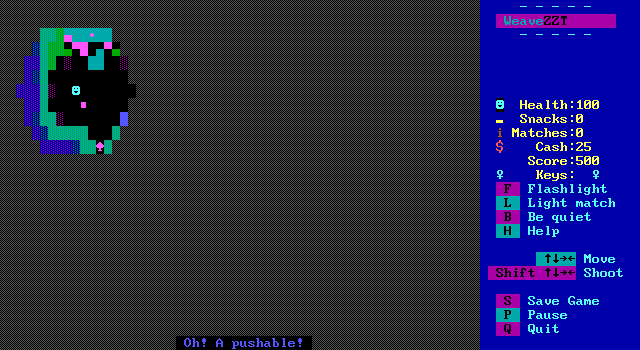
A bit of boulder pushing (now with arbitrary characters) and the classic button that swaps horizontal/vertical sliders to the other orientation round things out. I'd be hesitant to call Janowski a puzzle game, and Anna herself opted not to include the genre tag on the game. Head-scratchers they aren't, but it helps to keep the player engaged and give them time to soak in the surroundings instead of just zipping past them as one might in a pure walking sim. While the occasional pipe pushing I can get behind, the boulders and sliders really aren't put into the world as anything other than requisite puzzle pieces. For a game that's very heavy on creating interesting environments, the lack of fitting in these puzzles do may end up reminding you that you're just playing a video game here.
Later puzzles with mushrooms that can be made to grow or shrink do a nicer job of integrating themselves into the world being built and leave a much better lasting impression because of it. Really, it's the environment around Jennifer that brings the game together.
Jennifer Janowski is Going Underground
Putting aside the special effects only made possible by Weave, Anna excels when it comes to visual design, making Jennifer Janowski a very visually striking game. From its true to life mottled black-and-white notebook title screen, to the foreboding silhouette of the infamous Sallow house on a moonlit night, to the variety of designs in giant mushrooms of purple and cyan (Jill of the Jungle homage or Jill just having made an imprint on a younger me?), there's always something worth looking at. This works rather well with how much of the game takes place on dark boards. By restricting the player's sight, they can react to things no quicker than Jennifer. A lit room in ZZT reveals its contents all at once. In the dark though, there's an opportunity to surprise the player at any turn.
This is especially prevalent early on before Jennifer finds a flashlight, and must instead rely on matches that take over the role of ZZT's torches. Passages seem to shift with each pass, and I can never be sure if paths are opening and closing or if it's all in my head.
The cave walls are meanwhile as if they were catered specifically to my interests.
No really, during the livestream, Anna admitted to the coloring being inspired by remarks I had made. Those being, that while Janson's release of STK provided more color than ever before, it had the side effect of bringing a shift towards realism when deciding on colors. Prior to STK, a cave might be any of ZZT's seven bright colors that it makes available. Afterwards, everything turned brown and gray, forcing ZZTers to learn the lessons of the Xbox 360/ PlayStation 3/Wii generation a decade earlier...
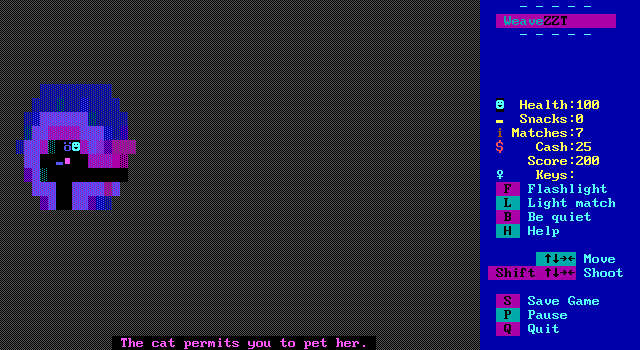
Instead, the game's catacombs favor purples and blues for its more organic walls that you'd sooner associate with trippy titles like Edible Vomit than with catacombs in a dungeon crawler such as Castlevania 827: Oh God not Again. It works heavily in the game's favor, giving it a very distinct vibe compared to the dozens of caves any seasoned ZZT player has delved into over the years.
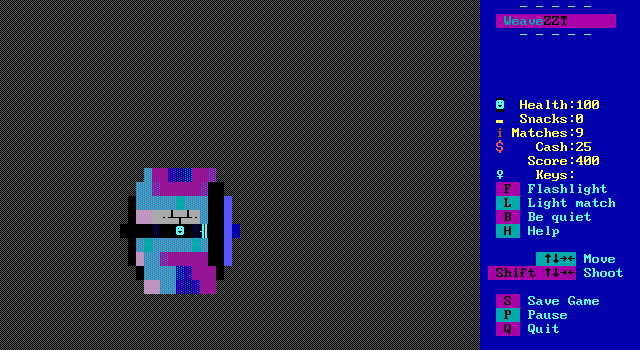
The masonry should also not be ignored as it would make Montresor blush. Brick texturing in ZZT has its origins with line walls where it tends to look a little too uniform, too tall, and too focused on the mortar between the "bricks". Alternatively, the same element can be used as the masonry to wrap around a larger sized brick, selling the effect better at the cost of any sense of scale (unless these are meant to be huge bricks).
Good looking walls are a plus sure, but that's not the full story here. Janowski is a very animated game as well. Again this combines great with the use of darkness throughout the adventure as seemingly every corner will have something to stop and gawk at for a moment once it's revealed. A rushing underground river winds its way through the catacombs with animated currents enhanced by Weave's ability to reliably generate random numbers to prevent it from being an observable loop. Eventually the river flows off a ledge where a small waterfall that could very well be an underground tourist destination.

Thanks to Weave allowing objects to check if they're in light or not, mushrooms are able to react to Jennifer's flashlight, sprouting eerily quickly when exposed, and just as rapidly withering when returned to darkness. Anna even uses this visual effect to function as a light (pun not intended) puzzle element where at times the only way to proceed is to shut off your light and navigate blindly in the dark past a patch of mushrooms before they can block her path. Even knowing as the player that there's nothing to fear in the dark in this game, there's a natural fear played at here. I couldn't help but make sure I didn't shut off my light until I was right next to a mushroom, and would frequently turn it on again just a little too early, not wanting to be in the dark for too long. How much of that is a genuine fear of the dark versus a genuine fear of having to navigate ZZT darkness sans torches is hard to say.
Darkness is clearly Anna's favorite mechanic in Weave, and it's easy to see why. In ZZT, darkness is a very rigid thing with very strict rules. Most elements don't show up in darkness, torches have a fixed duration that's designed for fast-paced action games more than lengthy exploration, and nothing in ZZT-OOP can really detect it.
Ruins of ZZT has a sequence that tries to capitalize on fear of darkness, and requires such a silly amount of setup that Weave allows Anna to avoid. A torch is placed in such a way that the player has to pick it up. An object has to check for it to not be on the board, and then to start checking if the player has any torches left to figure out if they lit it or not. A timer has to estimate when the torch has thus ran out in order to play up a scene where the player is now stuck in darkness. It's a significant amount of work for an effect that only clumsily functions.
Meanwhile back in Janowski, all it takes is one command to check if a match is lit and one command to check if the player is close enough to the mushroom to spring up.
#if wick is 0 #restart
#if not within 6 restart
Anna plays around quite a bit with darkness. When Jennifer first enters the catacombs, she'll have to fumble around in darkness, bumping into things and getting descriptions of what gross thing she just touched. At another point, she's temporarily separated from her flashlight and matches forces to bravely stumble once more. Perhaps the best use of this is to create little moments of surprise. The way the player's movement is guided across each board leads to some great moments where you'll be holding down a direction, catch a glimpse of something strange, only for it to vanish the moment you stop and start to second guess what you may have seen.
Is there somebody else down here with Jennifer, or was it just another one of the critters scurrying about? And was it just me, or did Jennifer's reflection in the water... stop following her for a moment? There's no real surprise as Jennifer goes deeper into the catacombs that something queer is going on. The details though, aren't so easily surmised.

The gameplay boards peak visually towards the final portion of the game when Jennifer discovers a small study lit by an arrangement of candles. The classic use of accented "i" characters for candles with dancing flames is used here, but for the first time, the irregularities of the light can be actually be reflected in how the board is presented as objects that make up the walls are able to freely change to any color requested. An equivalent board in classic ZZT would require a lot of sacrifices, as even with Weave increasing the stat limit to 255 (to maintain world format compatibility) this one weighs in at 247 stat elements.
Jennifer's Janowski is Japing
Just as Ms. Janowski can't help but find herself in a horrific situation, trapped inside the catacombs beneath a haunted house, she also can't help but laugh. Jennifer has a lot of comments to make at her surroundings. It's her own dialog that define the "horror" here. This isn't a game that intends to keep you up all night, but rather a theme park's idea of a haunted mansion and underground. Jennifer is presented as being scared, but she isn't cowardly. She still focuses on finding something for the paranormal society before securing an escape route. Mostly she keeps a level head that allows her to realize that scary and dangerous are two different things.
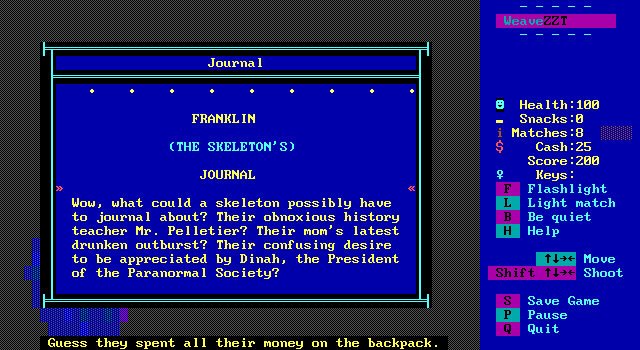
This lets her have more courageous feeling approaches to scary subjects. Coming across a skeleton might be a bad omen, but the deceased isn't exactly going to do anything to her. Jennifer's personality also gives her reason to not be so afraid. For one thing, she's trying to join a paranormal society so she better not be afraid of ghosts. Jennifer also displays an affection towards animals of all kinds, getting excited at finding a mouse hole, calling the rats of the catacombs cute, and of course winning the affection of a black cat she comes across.
There's a running joke with Jennifer constantly wishing she had packed some snacks for her trip to the Sallow house. What would be a simple gag is taken to the next level thanks to game's sidebar replacing "Ammo" with "Snacks", putting the importance of such an item on par with her health, matches, and cash. Alas, her snack counter will forever be zero, playing with the player's expectations that maybe she'll find a sealed package of cookies or something eventually. You can't help but root for her.
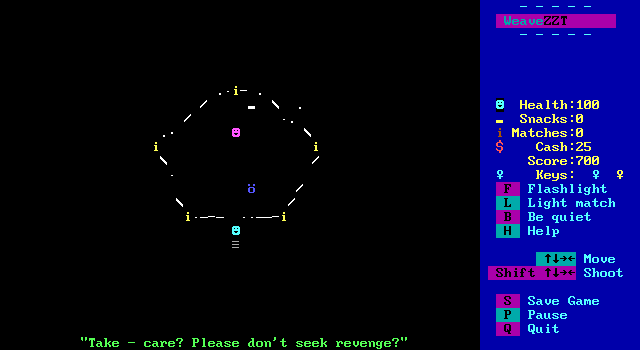
By the end of it, Jennifer seemingly finds herself in an unwinnable situation. The truth about what happened to old lady Sallow and her occult rituals is revealed putting Jennifer into mortal danger. For realsies. Jennifer Janowski is doomed after all. Her escape, at this point, comes as a surprise even to her, with the reason she can get away never being explicitly stated, but easy enough to infer, and yet having just a small bit of ambiguity as to what or who is specifically responsible for her newfound safety.
Here Jennifer has found a sufficiently cool item to present to the paranormal society, perhaps even as a gift to her crush Dinah. Now all that matters is getting out of here, thankfully handled by a jump cut to where she fell in the first place and cute scene of Jennifer taking some jumps of her own in an attempt to grab the decrepit old rope and hopefully pull herself up.
Can she make it, or will she be stuck in the catacombs forever? I won't spoil it. Playing it for yourself is the only way to learn if Jennifer Janowski is doomed.

